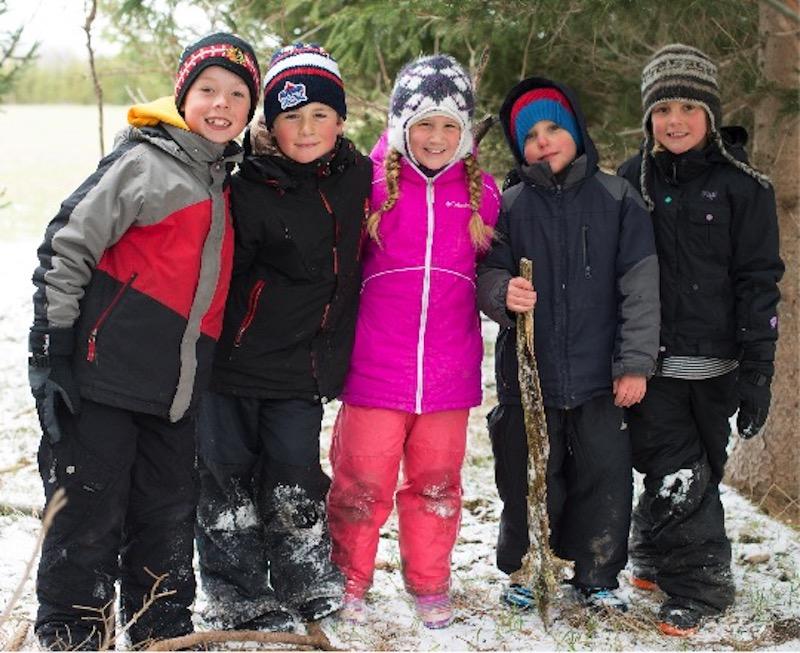
Little Falls Forest School: Where Kids Get Plugged in to Nature
“Why are we learning outdoors? … To wake up our brains” is the loud chorus from my Grade 2 students at Little Falls Public School. Outdoor learning is an integral part of their daily lives. These students come to school prepared; dressed in layers, with their water bottles, hats and splash pants, they are ready for a day of active learning. This preparation is as important as completing homework or remembering to bring their school planner.
I started the Forest School program at Little Falls two years ago after reading Last Child in the Woods: Saving Our Children From Nature-Deficit Disorder by Richard Louv. Louv talks about the absolute imperative of reconnecting children with nature to protect children’s personal well-being and to ensure that they care about their natural world. I was inspired by the message and convinced by the research.
The belief behind Forest School is the non-radical notion that we must ground children in their immediate natural surroundings. Children must know and appreciate what’s in their own backyard to recognize the real value of the nature that is part of their daily experience. Children of today seem to carry with them a vague yet intense concern for the health of the planet, an unfocused, unnamed worry that their world is under siege. They have heard about animals in distant lands becoming endangered or extinct, air and water being polluted and global warming devastating our planet. These same children can tell us more about animals in the rainforest than those that inhabit their own community. Their questions are about places and concepts far removed from their actual experience.
The disconnect from nature seems to be growing with the strong embrace of technology that envelopes the lives of children, keeping them focused up close on screens rather than being wide lens observers of natural cycles of life.
Reconnecting children with nature is the goal of our Forest School team at Little Falls. We believe that our students need to get plugged back in to nature and get to know the local flora and fauna, seasonal cycles, weather systems and environmental issues in their home communities. Through nature awareness education we hope to refocus each child’s understanding through the lens of the natural world.
In Forest School our day is filled with living things and the core routines that embed the children in their natural spaces. Following the familiar coyote call to gather outdoors to greet the morning, we join together to sing the morning song in a tight circle, before heading off to visit our tree friends on the schoolyard. Later, we come back to the log circle to share stories of recent adventures and observations from our wanderings. These are all small moments of our day in Forest School. The children tune in when the owl hoots to listen up, make a whole-group circle at the call of the chickadee or signal their friends to notice a passing bird with a “jay, jay” call. Each transition from one of our learning pockets to another is linked to the cardinal directions indicated by the motion of the sun across the sky. They celebrate what nature brings each day.
Every child in the class adopts the name of a local animal with qualities that match their own. We speak these animal names throughout every day so they become embedded in the language of our class community and the topics of our research. Animal names act as a guide to shape behaviour or as a reminder of positive learning habits. For example, the heron is always watchful and aware of others in its surroundings. In this there is a lesson for a child to follow.
Knowledge of local creatures paves the way for future wonderings; for example, if the cardinal and blue jay are at our feeder all winter, we wonder what happens to the oriole and the robin. Thanksgiving or thankfulness is also part of our daily practice. We model giving thanks for our well-being, our natural world and our elders and friends. Words of thanksgiving are spontaneously offered by the students in circle sharing, at our “tribe” tables and in “bouquets” offered to each other after class meetings.
Students in our Forest School program see themselves as “nature kids” and know that their teachers value their stories and wonderings about the natural world around them. These children recognize the distinct leaf shape of the burr oak and know the habits of the wintering white-tailed deer. They can tie knots, build a campfire and identify the local birds across the seasons. Their young minds are brimming with questions about the creatures they hold in their hands, the tracks under their shoes, and the bones and scat uncovered on the pathways that whisper a story they are now able to hear. These same children may have trekked through a local park or walked a forest path in months past without noticing life happening around them. Suddenly, they are awake to their natural surroundings and feel that special connection that comes from direct “hands dirty” experience. Nature can always be counted on to amaze, surprise or disgust, enlivening each day with the adventure of an ever-unfolding story.
Our Forest School program includes regular day-long visits to an Outdoor School site where a rich natural diversity exists for our students to explore. We established a relationship with Cobi Sauder, a skilled nature educator who owns a 100-acre property a short bus ride from our school. Cobi is a mentor and co-facilitator for our adventures on the property. The children love this part of Forest School. The plans for our visits to Outdoor School happen in a unique collaboration between our Forest School teachers and Cobi via phone and email in the week preceding our visit. The focus in our planning is a blend of what the weather holds, the seasonal activities of wildlife, or interesting natural occurrences on the property (like seed pods dropping or discovering an animal skeleton), along with the students’ recent inquiry questions and current curriculum. We invite along a couple of parents each visit to be parent guides. They attend to support the learning and quickly become ambassadors for our program.
Like Forest School, Outdoor School is filled with its own established core routines and traditions. The day begins in an old timber frame barn, around a huge rough plank table sharing a first observation or focusing thought on the day ahead. This is followed by our morning pledge within which lie four touchstones – trusting hearts, helpful hands, gentle footsteps and backwoods roots – to guide all aspects of our daily experience. Visits to our tree friends, sit-spot reflection time at each child’s chosen sheltered spot, drumming calls, map reading, gathering for lunch around a stone fire pit, and even the hand washing in warm water from the old thermos, are cherished parts of our Outdoor School experience. Our students have an affinity with this site and their footsteps become familiar with the natural terrain, such as hiding within a tight grove of conifers, exploring under the weeping willow or sneaking into the hardwood stand. This connects them with the landscape and the changes within it.
The rich learning and deep thinking about the many topics of interest at Outdoor School provides the fodder for our writing, reading, science and other curriculum-based learning back at Little Falls. The problem-solving and creative play that spontaneously occur in wander time or around the campfire strengthen peer bonds. Dealing with cold and wind, or being wet or tired builds a culture of caring as the kids help each other cope and persevere. Issues of behaviour or self-regulation are resolved directly by the peer group and the desire to be included in the wave of positive energy dampens the resolve of resisters, complainers and those who may withdraw from challenge, hard work and risk. What is recognized gradually over the first months of school is that we are stronger together.
Everyone is included, finds their islands of competence and shines on this diverse learning journey, especially children who struggle in a conventional classroom. In the outdoor classroom, these children are able to demonstrate their knowledge, take a lead role and gain social credibility in tasks that challenge them in completely new ways. This was clearly evident in a recent activity where tribe groups were given backpacks with water, snacks, binder twine, a tarp, paper with pencil and a compass. They were presented with a scenario in which they were lost in a forested area and needed to prepare to spend the night as darkness was falling. A quiet, demure, very tiny girl with low academic skills and many assessed areas of deficit immediately took charge of the situation. She organized her tribe mates, planned the best shelter, reserved food and water for a later need and expressed concerns about firewood supplies. This clearly earned the admiration of her peers. An experience like this for a child can have a lasting effect, building confidence and stronger ties with the peer group. This type of success has been repeated over and over in Forest School, particularly among children with special learning needs or challenging behaviours.
The Forest School program is not new. Forest or Nature Schools have been established in many places around the world since the early 1950s. They are especially prevalent in Europe where about 10,000 exist today. The Grade 2 demonstration program that I started in St. Marys is modelled on the same principles as all Forest Schools. Forest School programs take the learning outdoors whenever possible. It is important that students return to the same natural settings around their schoolyard and in community parks, ponds, rivers and open spaces to learn as the seasons change. This leads to deeper connections with and understanding of the natural cycles of life, heightens curiosity and presents ever-changing obstacles and challenges. In Forest School, nature becomes another teacher. The key underlying belief in Forest School programs is that children are competent and engaged learners; with support and guidance these children are able to take their learning in directions far beyond what educators can initiate on their own.
The head, heart, hand connection makes Forest School a perfect forum for retaining knowledge, sparking inquiry and expanding critical thinking. We do use technology to support outdoor learning, for purposes of research, confirming our thoughts and expressing opinions; however, it plays a supportive and enriching role. Nature is centre stage.
Where can Forest School go from here in public education? It is our hope that teachers, administrators and boards of education will embrace the idea, and nourish and grow it through the system. This can be our legacy in preparing students for the unavoidable task ahead of them – caring enough, knowing enough and wanting enough to make the difficult choices to protect our planet.
Kendra Martin is a member of the Avon Maitland Teacher Local. For further information, contact Kendra at kendmart@fc.amdsb.ca or visit the Forest School Blog at edublog.amdsb.ca/forestschool/

